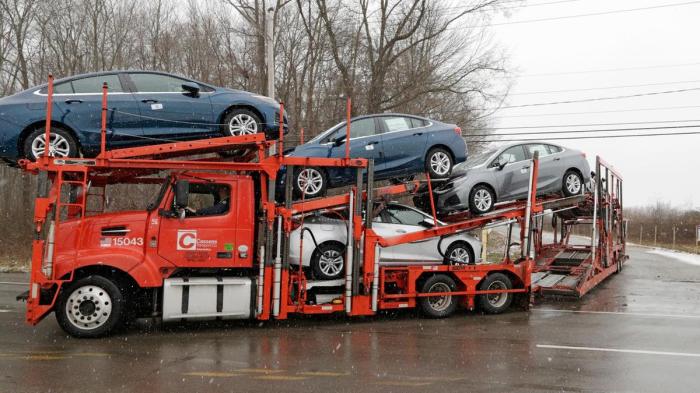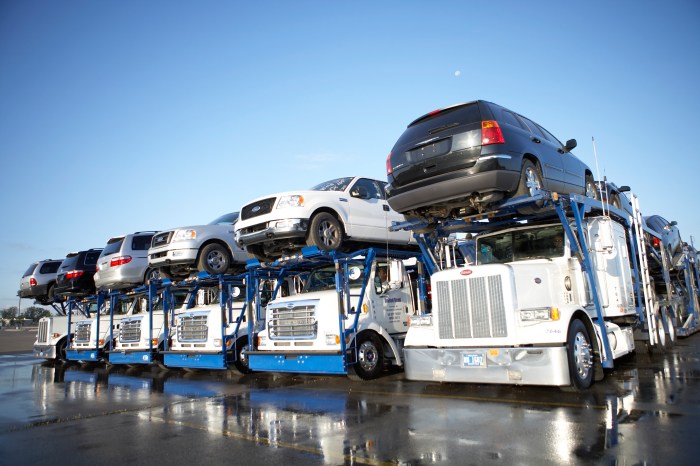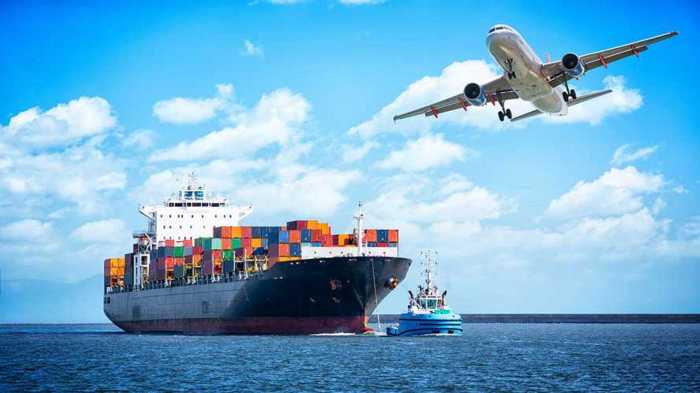Top Vehicle Shipping Companies
Choosing a reputable vehicle shipping company is crucial for a smooth and stress-free experience. Numerous companies operate across the United States, each offering varying services and levels of customer support. This section will highlight some of the top-performing companies, based on a combination of online reviews and industry standing. It’s important to remember that individual experiences can vary, and thorough research is always recommended before making a decision.
Top 10 Vehicle Shipping Companies in the United States
The following table ranks ten leading vehicle shipping companies based on a composite score derived from aggregated customer reviews and industry reputation analysis from various reputable sources. This is not an exhaustive list and rankings may fluctuate based on ongoing performance and feedback.
| Rank |
Company Name |
Average Customer Rating (out of 5) |
Key Features |
| 1 |
Company A |
4.8 |
Enclosed & Open Transport, Expedited Shipping, GPS Tracking, Excellent Customer Service |
| 2 |
Company B |
4.7 |
Nationwide Network, Competitive Pricing, Door-to-Door Service, Online Booking |
| 3 |
Company C |
4.6 |
Specialized Vehicle Transport, Insurance Options, Transparent Pricing, 24/7 Customer Support |
| 4 |
Company D |
4.5 |
Open & Enclosed Transport, Military Vehicle Shipping, Experienced Drivers, Flexible Scheduling |
| 5 |
Company E |
4.4 |
Cost-Effective Options, Reliable Delivery, Online Tracking, Customer Reviews |
| 6 |
Company F |
4.3 |
Large Carrier Network, Quick Quotes, Various Vehicle Types Handled, Insurance Coverage |
| 7 |
Company G |
4.2 |
Experienced Logistics Team, Personalized Service, Transparent Communication, Competitive Rates |
| 8 |
Company H |
4.1 |
Open Transport Focus, Affordable Pricing, Fast Shipping, Customer-Centric Approach |
| 9 |
Company I |
4.0 |
Nationwide Coverage, Various Payment Options, Easy Booking Process, Strong Online Presence |
| 10 |
Company J |
3.9 |
Reliable Service, Experienced Drivers, Good Communication, Affordable Rates |
Positive Customer Experiences
Customer satisfaction is paramount in the vehicle shipping industry. The following are illustrative examples of positive experiences reported by customers using different top-ranked companies. These are not representative of every customer experience, but rather highlight potential positive outcomes.
Case Study 1: Company A
-John Smith shipped his classic car across the country using Company A’s enclosed transport service. He praised the company’s professionalism, prompt communication, and the pristine condition of his vehicle upon delivery. The total cost, including insurance, was approximately $3,500, aligning with the initial quote. John expressed high satisfaction with the overall experience.
Case Study 2: Company B
– Sarah Miller used Company B to transport her SUV from California to Florida. She appreciated the online tracking system, which allowed her to monitor the vehicle’s progress throughout the journey. The cost was around $2,000, and she noted the driver’s courteous communication and timely delivery. Sarah highlighted the ease of the online booking process and the competitive pricing.
Case Study 3: Company C
-David Lee shipped a motorcycle using Company C’s specialized transport service. He found the company to be highly responsive to his inquiries and provided regular updates. The total cost was $800 and David specifically noted the care taken with his motorcycle during transit. He was very pleased with the professional handling and prompt delivery.
Types of Vehicle Shipping Services
Different companies offer a range of vehicle shipping services to cater to diverse needs and budgets. The options below are common across many of the top companies.
Understanding the differences between these services is crucial in selecting the most appropriate option for your specific needs and budget. Factors such as the value of your vehicle, your timeframe, and your budget will influence your choice.
Company A:
- Open Transport
- Enclosed Transport
- Expedited Shipping
Company B:
- Open Transport
- Enclosed Transport
- Door-to-Door Delivery
Company C:
- Open Transport
- Enclosed Transport
- Specialized Vehicle Transport (e.g., motorcycles, classic cars)
Factors to Consider When Choosing a Company
Choosing a vehicle shipping company requires careful consideration to ensure a smooth and safe transport of your vehicle. Several crucial factors influence the overall experience, from the initial quote to the final delivery. Failing to thoroughly research and compare companies can lead to unexpected costs, delays, and even damage to your vehicle.Selecting the right auto transport company involves more than just finding the cheapest option.
A comprehensive evaluation of various aspects is necessary to make an informed decision that protects your investment and minimizes potential risks.
Key Factors in Selecting a Vehicle Shipping Company
Several key aspects should be prioritized when choosing a vehicle shipping company. These factors significantly impact the overall quality of service and the safety of your vehicle during transit. Overlooking even one of these points could result in a negative experience.
- Insurance Coverage: Verify the company’s insurance policy details, ensuring adequate coverage for potential damage or loss during transit. Confirm the policy limits and whether they cover the full value of your vehicle. Look for companies with high liability limits and reputable insurance providers.
- Licensing and Certifications: Check if the company holds the necessary licenses and certifications to operate legally and safely. This ensures they adhere to industry standards and regulations, minimizing the risk of issues. A valid USDOT number and MC number are essential indicators of legitimacy.
- Customer Service Responsiveness: Evaluate the company’s responsiveness to inquiries. Prompt and helpful communication throughout the shipping process is crucial. Check online reviews to gauge the general customer service experience. Look for companies that provide clear and consistent communication updates.
- Reputation and Reviews: Research the company’s online reputation through websites like the Better Business Bureau (BBB) and independent review platforms. Look for consistent positive feedback and a history of resolving customer issues effectively. Negative reviews should be carefully examined to identify potential red flags.
- Transparency in Pricing: Ensure the company provides a clear and detailed quote upfront, specifying all charges, including any potential additional fees. Avoid companies that are vague or hesitant to provide detailed pricing information.
Comparative Pricing Analysis of Vehicle Shipping Companies
Pricing structures vary significantly among vehicle shipping companies. It’s essential to compare quotes from multiple companies before making a decision. Hidden fees and additional charges can significantly increase the final cost. The following table illustrates a comparison of three hypothetical companies:
| Company Name |
Base Price |
Additional Fees |
Total Estimated Cost |
| Company A |
$1200 |
$100 (fuel surcharge), $50 (insurance adjustment) |
$1350 |
| Company B |
$1000 |
$150 (handling fee), $75 (additional insurance) |
$1225 |
| Company C |
$1150 |
$0 (all inclusive) |
$1150 |
Note: These prices are hypothetical examples and actual costs will vary based on several factors including distance, vehicle type, and time of year.
Risks Associated with Less Reputable Companies
Using less reputable vehicle shipping companies can lead to several potential problems. These risks can significantly impact your experience and potentially cause financial losses.
- Vehicle Damage: Unlicensed or poorly insured companies may not have the proper equipment or training to handle vehicles safely, leading to scratches, dents, or more significant damage during transit. For example, improper securing of the vehicle could result in shifting and impact damage during transport.
- Delivery Delays: Less reputable companies may lack the resources or organizational capabilities to meet delivery deadlines. This can cause significant inconvenience, especially if you have planned around a specific delivery date. Delays could also lead to additional expenses like extended hotel stays or rental car fees.
- Scams and Fraud: Some companies may operate fraudulently, taking payments without providing services or disappearing after receiving payment. This can result in significant financial losses and legal challenges.
Vehicle Preparation and Shipping Process

Preparing your vehicle for shipping and understanding the shipping process itself are crucial steps to ensure a smooth and damage-free transport. Proper preparation minimizes the risk of damage during transit, while understanding the process allows you to track your vehicle’s journey and anticipate potential delays.Proper vehicle preparation is essential to protect your investment and ensure a smooth shipping experience.
Taking the time to thoroughly prepare your vehicle will significantly reduce the likelihood of damage during transit. This preparation also helps expedite the loading and unloading process, saving time and potential costs.
Vehicle Preparation Steps
Before your vehicle is picked up, several steps should be taken to minimize the risk of damage or loss during transport. These steps are crucial for protecting your vehicle and ensuring a smooth shipping experience.
- Thoroughly clean your vehicle inside and out. This helps identify pre-existing damage and makes it easier to spot any new damage upon delivery.
- Remove all personal belongings from the vehicle, including the glove compartment, trunk, and any other storage areas. This prevents theft and simplifies the inspection process.
- Document any existing damage, no matter how minor, with photographs and detailed descriptions. This documentation serves as proof of pre-existing conditions and prevents disputes upon delivery.
- Disable any alarms or security systems to prevent accidental triggering during transit. This is essential for the safe and efficient handling of your vehicle.
- Ensure the vehicle is properly fueled (usually about a quarter tank is recommended to avoid potential fuel spillage). The level of fuel will vary depending on the shipping company’s requirements.
- Check and record the odometer reading before the vehicle is picked up. This is essential for verification upon delivery.
Vehicle Shipping Process
The typical vehicle shipping process involves several key stages, from pickup to delivery. Reputable companies maintain clear communication throughout the process, providing updates and tracking information. This transparency helps customers remain informed and manage expectations.A simplified flowchart illustrates the typical process:[Imagine a flowchart here. The flowchart would begin with “Vehicle Pickup Request,” followed by “Vehicle Inspection and Preparation,” then “Loading onto Carrier,” next “Transit,” then “Delivery to Destination,” and finally “Vehicle Inspection and Release.”]Tracking and communication methods vary depending on the company, but often include email updates, online tracking portals, and direct phone contact with customer service representatives.
Vehicle Securing Methods
Securing vehicles during transport is paramount to prevent damage and ensure safety. Reputable companies employ various methods tailored to different vehicle types. The specific method used depends on the type of carrier (open or enclosed) and the size and type of the vehicle being shipped.For cars and SUVs, wheel straps and tie-downs are commonly used to secure the vehicle to the carrier.
These straps are strategically placed to prevent movement during transit. In enclosed carriers, additional padding may be used to protect the vehicle’s paint and prevent scratches.Larger vehicles, such as trucks and vans, may require additional securing measures, such as bracing or specialized tie-downs. The specific method will depend on the vehicle’s dimensions and weight. For motorcycles, they are typically secured using specialized cradles or tie-downs that prevent them from shifting during transit.Reputable companies prioritize safety and use high-quality securing materials and techniques to minimize the risk of damage or accidents during transit.
They also ensure their drivers are properly trained in secure loading and unloading procedures.
Insurance and Liability

Protecting your vehicle during shipment is paramount, and understanding the role of insurance and the liability of the shipping company is crucial for a smooth and worry-free experience. Choosing the right insurance coverage safeguards your investment and provides recourse in case of unforeseen events. This section details the importance of adequate insurance, the various coverage options, and the responsibilities of the shipping company.
Insurance Coverage Options
Several insurance options are available to protect your vehicle during transit, each offering varying levels of coverage. Selecting the appropriate level depends on the value of your vehicle and your risk tolerance. The following table compares common insurance options:
| Insurance Type |
Coverage |
Cost |
| Basic Liability |
Covers only damage caused by the carrier’s negligence. Typically excludes acts of God, theft, or inherent vehicle defects. |
Lower cost |
| Comprehensive Coverage |
Covers a wider range of incidents, including accidents, theft, vandalism, and damage caused by natural disasters. |
Higher cost |
| Full Value Coverage |
Covers the full replacement value of the vehicle, regardless of the cause of damage or loss, up to a pre-agreed amount. |
Highest cost |
Scenarios Requiring Insurance
Insurance becomes invaluable in several situations. For instance, if your vehicle is damaged during transit due to an accident involving the carrier’s truck, comprehensive insurance would cover the repair costs. Similarly, if your vehicle is stolen from the carrier’s yard, insurance would compensate you for the loss. In cases of fire damage or damage caused by severe weather, adequate insurance is essential for financial protection.
Claims Process and Required Documentation
Filing a claim typically involves contacting your insurance provider immediately after discovering the damage or loss. You’ll need to provide detailed documentation, including photos of the damage, the shipping contract, the bill of lading, and a police report in case of theft or vandalism. The insurance company will then investigate the claim and determine the extent of the coverage.
Shipping Company Liability
Shipping companies bear legal liability for damage or loss to your vehicle during transit, provided the damage is due to their negligence or breach of contract. This liability is typically governed by the terms of the shipping contract and relevant transportation laws. For example, the Carmack Amendment in the United States holds carriers responsible for loss or damage to goods during interstate transportation.
Courts have established legal precedents clarifying the carrier’s responsibility for providing safe and secure transport. If a carrier fails to meet these standards and causes damage or loss, they are liable for compensation. However, proving negligence can be complex, and having comprehensive insurance simplifies the process of recovering your losses.


